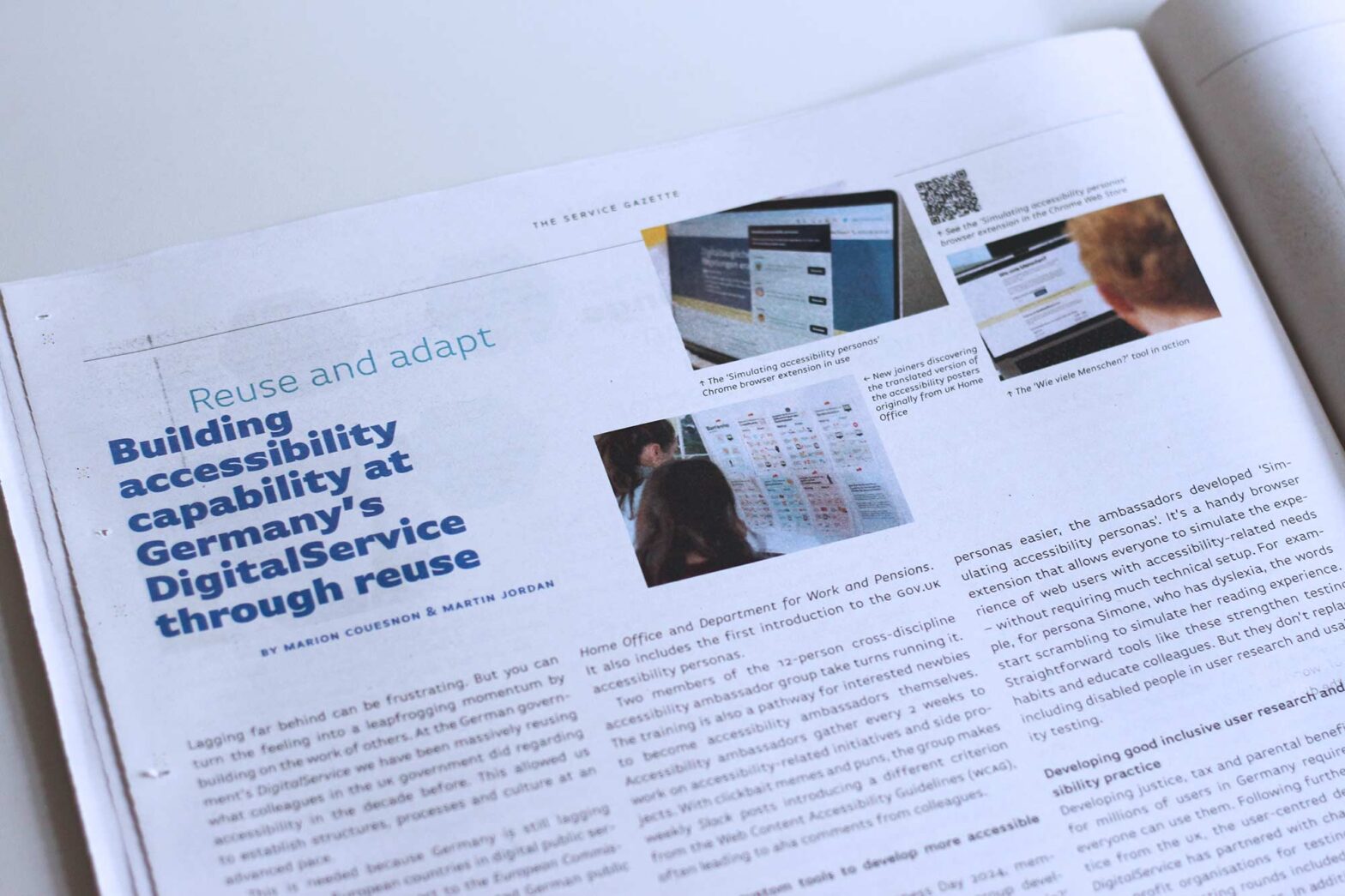The new Service Gazette is out. And we started putting the first articles online, too.
Marion’s and my article on ‘Building accessibility capability at Germany’s DigitalService through reuse’ is published on Medium.
Hillary Hartley’s text on ‘digital service resilience’ went also online.
More texts from the Service Gazette will come soon.
I also managed to edit the first video from the Amsterdam conference. I will edit further ones next week.
The first talk from last week’s Amsterdam #UserNeedsFirst #GovDesign conference is up on YouTube: Stephanie Kaiser, Chief Product Officer of @digitalservice.bund.de, on ‘Change through delivery’ and a transformation approach for the complex German government system. Enjoy! 📺
— Martin Jordan (@martinjordan.com) April 14, 2025 at 8:03 AM
[image or embed]
Designing content
In the few days of the short week, I joined various content design sessions with members of the Service Standard team. Content designer Linn now has the first draft of the overview for each of the 13 standard points. I started reviewing them. We are trying to find the right angle and level of abstraction for people new to service quality standards, people in commissioning roles with little digital expertise and folks working in digital teams.
On Tuesday afternoon, Marion and I spent time on a new accessibility page for our organisation’s website. Building on the momentum from the Service Gazette text and with various accessibility-related events ahead of us, it makes sense to finally establish an overview of the multiple activities, formats and tools we have created.
Discussing automation and the use of AI in government
Over lunchtime on Tuesday, Maria and I invited to our first NExT user-centred design community gathering of 2025.
We discussed automation and the use of AI in government. Some 35 people signed up. A little over 20 people joined. Once again, it included people from all parts and levels of German government, including local government and even a UX designer working for the Federal Bar Association.
We spent almost 2 hours talking about examples of robotic automation as a patch before old systems can be redesigned more fundamentally. A colleague from the federal pension provider Deutsche Rentenversicherung Bund shared their ongoing work on an AI-powered caseworking tool. They take a progressive co-design approach involving a substantial number of key users in the development process. There might be a case study for the Service Standard to record and share.
Opening up design roles
Why would organisations not show the salary range in a job ad? I wondered that when returning to Germany. In the UK, that’s mostly standard practice: displaying the expected salary. In Germany, it’s not. But it will be—with a forthcoming change of law in 2026.
When I joined DigitalService I asked our Head of People, Anna-Lisa about this, too. She agreed and asked me for some time to work things out. In the following months, the people team worked with the heads of disciplines to rework salary bands, level descriptions and skill matrices.
Even public sector organisations with collective wage agreements only state a letter-number code in their job adverts. Applicants then need to decode what it means in remunerative terms. I don’t get why.
One of our values at DigitalService is working openly. That includes how we handle salaries. Anna-Lisa wrote a comprehensive blog post about it last September. It made some waves, including in other public sector digital units.
We just opened mid-level roles for UX/UI design. In the job ad, we state the salary range of 55 to 65k. We pay along market levels but won’t match salaries at global tech titans. I think that’s fair. We have an obligation to the people in our country to spend their tax money well.
On LinkedIn, I asked people to look at the job and let others know about it! Within 3 days, we received over 100 applications for the role. After the Easter weekend, we’ll look closer at who is suitable for the role.
What’s next
The post-Easter week might be calmer. Many colleagues are extending the long weekend. I’m hoping for that. After 2 weeks of train-travelling through Europe and doing little work, I need to catch up on some things.
There are things to prepare for a Service Standard content workshop the following week.
And on Wednesday afternoon, I am going to record another podcast. I will talk about service design in government and the Service Standard – what else?!
I will also do more Service Gazette communication – for the current and the next edition, which we plan to put together for early June.

